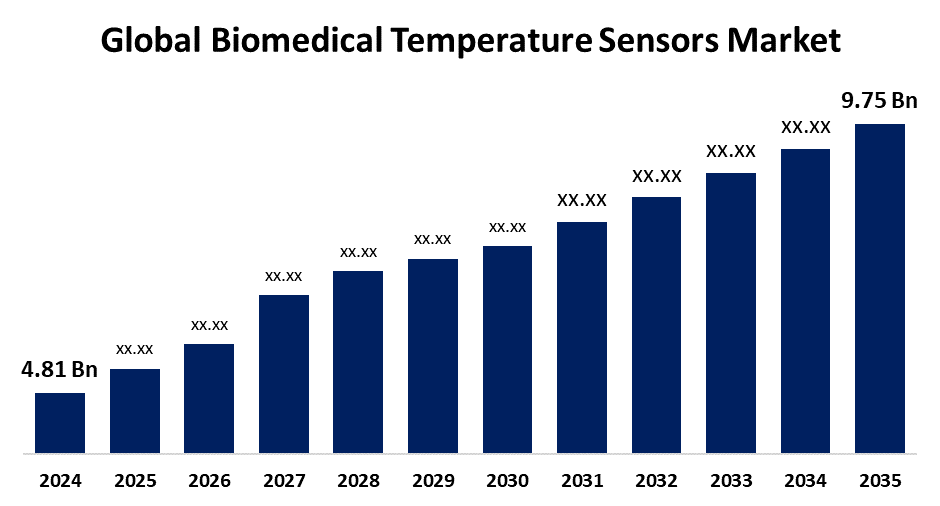Global Biomedical Temperature Sensors Market Size, Share, and COVID-19 Impact Analysis, By Product Type (Infrared Sensors, Thermocouples, Thermistors, and Resistance Temperature Detectors), By Installation Type (Portable Devices and Fixed Devices), By Application (Clinical Diagnosis, Patient Monitoring, Research & Development, and Thermal Management), By End Use (Hospitals, Diagnostic Laboratories, Research Institutions, and Home Healthcare), and By Region (North America, Europe, Asia-Pacific, Latin America, Middle East, and Africa), Analysis and Forecast 2025 - 2035.
Industry: HealthcareGlobal Biomedical Temperature Sensors Market Insights Forecasts to 2035
- The Global Biomedical Temperature Sensors Market Size Was Estimated at USD 4.81 Billion in 2024
- The Market Size is Expected to Grow at a CAGR of around 6.63% from 2025 to 2035
- The Worldwide Biomedical Temperature Sensors Market Size is Expected to Reach USD 9.75 Billion by 2035
- Asia Pacific is expected to Grow the fastest during the forecast period.

Get more details on this report -
The Global Biomedical Temperature Sensors Market Size was worth around USD 4.81 Billion in 2024 and is predicted to Grow to around USD 9.75 Billion by 2035 with a compound annual growth rate (CAGR) of 6.63% from 2025 to 2035. Increasing spending on diagnostics, demand for fitness devices, and growing health concerns are driving the biomedical temperature sensors market worldwide.
Market Overview
The biomedical temperature sensors market is an industry emphasizing the development, manufacturing, and sale of temperature sensors, especially used in medical devices. The sensor is required for accurate and reliable monitoring of critical temperature measurement. Further, application examples include hemodialysis, polymerase chain reaction (PCR) thermal cyclers, and sterilization of medical equipment. There is an increasing demand for patient monitoring systems in healthcare facilities, with the increasing need for remote patient care and telemedicine, for accurate and reliable temperature sensing in biomedical temperature sensors. Advancement in wireless sensor technologies, as well as integration of smart devices, along with the trend towards IoT applications in healthcare for real-time monitoring and instant data sharing, is escalating the market growth opportunities.
Report Coverage
This research report categorizes the biomedical temperature sensors market based on various segments and regions, forecasts revenue growth, and analyzes trends in each submarket. The report analyses the key growth drivers, opportunities, and challenges influencing the biomedical temperature sensors market. Recent market developments and competitive strategies such as expansion, type launch, development, partnership, merger, and acquisition have been included to draw the competitive landscape in the market. The report strategically identifies and profiles the key market players and analyses their core competencies in each sub-segment of the biomedical temperature sensors market.
Global Biomedical Temperature Sensors Market Report Coverage
| Report Coverage | Details |
|---|---|
| Base Year: | 2024 |
| Market Size in 2024: | USD 4.81 Billion |
| Forecast Period: | 2025-2035 |
| Forecast Period CAGR 2025-2035 : | 6.63% |
| 2035 Value Projection: | USD 9.75 Billion |
| Historical Data for: | 2020-2023 |
| No. of Pages: | 204 |
| Tables, Charts & Figures: | 110 |
| Segments covered: | By Product Type, By Installation Type, By Application, By End Use and By Region |
| Companies covered:: | GE Healthcare, Thermo Fisher Scientific, Siemens, Emerson Electric, Bourns, NXP Semiconductors, Rockwell Automation, Analog Devices, Honeywell, STMicroelectronics, Texas Instruments, Omega Engineering, Medtronic, Vishay Intertechnology, and Others |
| Pitfalls & Challenges: | COVID-19 Impact, Challenges, Future, Growth, & Analysis |
Get more details on this report -
Driving Factors
The widespread application of the devices includes cryogenic applications like drug development and vaccine transport to high-temperature applications like gas chromatography and harsh environments found in autoclaves and sterilizers, which are driving the market. The use of temperature sensors in wearable devices for health monitoring, providing continuous updates on body temperature, for optimizing their physical activities based on body heat data is propelling the market demand. Further, the application of temperature sensing for medical devices, including cardiac care, respiratory care, skin surface, thermometry, dialysis, and surgical aids, with the growing health concerns, is propelling the market growth.
Restraining Factors
The stringent regulatory requirements, supply chain disruptions, and geopolitical uncertainties are challenging the market. Further, volatility in raw material prices negatively affects the production cost of the device, thereby hampering the market growth.
Market Segmentation
The biomedical temperature sensors market share is classified into product type, installation type, application, and end use.
- The infrared sensors segment dominated the market with a significant share in 2024 and is expected to grow at a significant CAGR during the projected period.
Based on the product type, the biomedical temperature sensors market is divided into infrared sensors, thermocouples, thermistors, and resistance temperature detectors. Among these, the infrared sensors segment dominated the market with a significant share in 2024 and is expected to grow at a significant CAGR during the projected period. Infrared sensors measure the temperature of an object or surface by detecting the infrared radiation emitted by it and converting it into an electrical signal. The vital role of infrared sensors in clinical settings, for non-contact measurement capability, is driving the market.
- The portable devices segment dominated the biomedical temperature sensors market and is anticipated to grow at a significant CAGR during the projected period.
Based on the installation type, the biomedical temperature sensors market is divided into portable devices and fixed devices. Among these, the portable devices segment dominated the biomedical temperature sensors market and is anticipated to grow at a significant CAGR during the projected period. Portable devices are flexible and convenient, enabling real-time monitoring in emergency services. Further, an increasing demand for home healthcare, with rising need for remote monitoring solutions for improved healthcare delivery contributing to driving the market demand.
- The clinical diagnosis segment dominated the market with a major share in 2024 and is projected to grow at a substantial CAGR during the forecast period.
Based on the application, the biomedical temperature sensors market is divided into clinical diagnosis, patient monitoring, research & development, and thermal management. Among these, the clinical diagnosis segment dominated the market with a major share in 2024 and is projected to grow at a substantial CAGR during the forecast period. This sensor is used for patients suffering from conditions, including infections, hypothermia. The significant role of biomedical temperature sensors for the diagnosis and management of disease treatment is driving the market.
- The hospitals segment accounted for the largest market share in 2024 and is anticipated to grow at a significant CAGR during the forecast period.
Based on the end use, the biomedical temperature sensors market is divided into hospitals, diagnostic laboratories, research institutions, and home healthcare. Among these, the hospitals segment accounted for the largest market share in 2024 and is anticipated to grow at a significant CAGR during the forecast period. In hospitals, biomedical temperature sensors enable precise, real-time control, ensuring that conditions are appropriate for both patients and the storage of sensitive medications. The reliability of accuracy of biomedical temperature sensors for patient monitoring systems in hospitals are responsible for driving the market.
Regional Segment Analysis of the Biomedical Temperature Sensors Market
- North America (U.S., Canada, Mexico)
- Europe (Germany, France, U.K., Italy, Spain, Rest of Europe)
- Asia-Pacific (China, Japan, India, Rest of APAC)
- South America (Brazil and the Rest of South America)
- The Middle East and Africa (UAE, South Africa, Rest of MEA)
North America is anticipated to hold a major share of the biomedical temperature sensors market over the predicted timeframe.

Get more details on this report -
North America is anticipated to hold the largest share of the biomedical temperature sensors market over the predicted timeframe. The presence of advanced healthcare infrastructure, driving innovation for precision medical devices, is significantly propelling the market in the region. Further, the adoption of wireless technologies in the device is contributing to driving the biomedical temperature sensors market growth.
Asia Pacific is expected to grow at a rapid CAGR in the biomedical temperature sensors market during the forecast period. The crucial role of the sensors for monitoring body temperature, and in devices like thermometers & wearable health devices, is driving the biomedical temperature sensors market. Further, increasing healthcare infrastructure improvements and healthcare spending, with the driving need for advanced healthcare technologies, contribute to propelling the market growth.
Europe is anticipated to hold a significant share of the biomedical temperature sensors market during the forecast period. Investment in healthcare technology, along with an increased emphasis on patient safety and care efficiency contributing to propel the market growth. An increased demand for biomedical temperature sensors for diabetic and heart patients, along with technological advancements including the use of nano & microtechnology, is propelling the market demand.
Competitive Analysis:
The report offers the appropriate analysis of the key organizations/companies involved within the biomedical temperature sensors market, along with a comparative evaluation primarily based on their type of offering, business overviews, geographic presence, enterprise strategies, segment market share, and SWOT analysis. The report also provides an elaborative analysis focusing on the current news and developments of the companies, which includes type development, innovations, joint ventures, partnerships, mergers & acquisitions, strategic alliances, and others. This allows for the evaluation of the overall competition within the market.
- GE Healthcare
- Thermo Fisher Scientific
- Siemens
- Emerson Electric
- Bourns
- NXP Semiconductors
- Rockwell Automation
- Analog Devices
- Honeywell
- STMicroelectronics
- Texas Instruments
- Omega Engineering
- Medtronic
- Vishay Intertechnology
- Others
Key Target Audience
- Market Players
- Investors
- End-users
- Government Authorities
- Consulting And Research Firm
- Venture capitalists
- Value-Added Resellers (VARs)
Market Segment
This study forecasts revenue at global, regional, and country levels from 2020 to 2035. Spherical Insights has segmented the biomedical temperature sensors market based on the below-mentioned segments:
Global Biomedical Temperature Sensors Market, By Product Type
- Infrared Sensors
- Thermocouples
- Thermistors
- Resistance Temperature Detectors
Global Biomedical Temperature Sensors Market, By Installation Type
- Portable Devices
- Fixed Devices
Global Biomedical Temperature Sensors Market, By Application
- Clinical Diagnosis
- Patient Monitoring
- Research & Development
- Thermal Management
Global Biomedical Temperature Sensors Market, By End Use
- Hospitals
- Diagnostic Laboratories
- Research Institutions
- Home Healthcare
Global Biomedical Temperature Sensors Market, By Regional Analysis
- North America
- US
- Canada
- Mexico
- Europe
- Germany
- UK
- France
- Italy
- Spain
- Russia
- Rest of Europe
- Asia Pacific
- China
- Japan
- India
- South Korea
- Australia
- Rest of Asia Pacific
- South America
- Brazil
- Argentina
- Rest of South America
- Middle East & Africa
- UAE
- Saudi Arabia
- Qatar
- South Africa
- Rest of the Middle East & Africa
Frequently Asked Questions (FAQ)
-
1. What is the CAGR of the biomedical temperature sensors market over the forecast period?The global biomedical temperature sensors market is projected to expand at a CAGR of 6.63% during the forecast period.
-
2. What is the market size of the biomedical temperature sensors market?The global biomedical temperature sensors market size is expected to grow from USD 4.81 Billion in 2024 to USD 9.75 Billion by 2035, at a CAGR of 6.63% during the forecast period 2025-2035.
-
3. Which region holds the largest share of the biomedical temperature sensors market?North America is anticipated to hold the largest share of the biomedical temperature sensors market over the predicted timeframe.
Need help to buy this report?